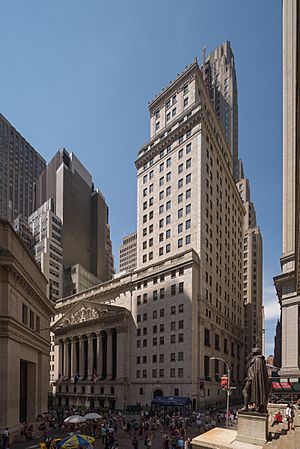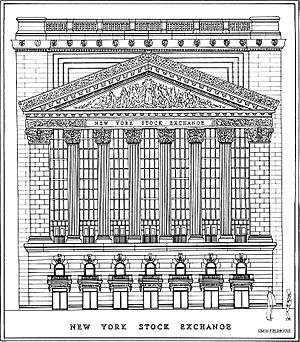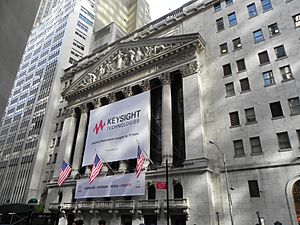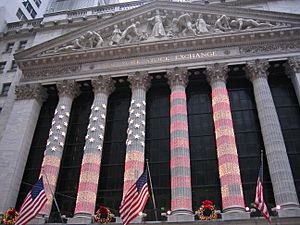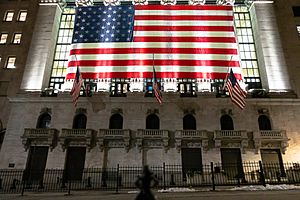New York Stock Exchange Building facts for kids
|
New York Stock Exchange
|
|
|
U.S. Historic district
Contributing property |
|
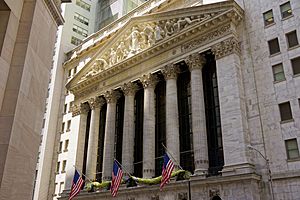
Broad Street facade of the 18 Broad Street section of the building
|
|
| Location | 18 Broad Street, Manhattan, New York |
|---|---|
| Built | 1903 |
| Architect | Trowbridge & Livingston; George B. Post |
| Architectural style | Classical Revival |
| Part of | Wall Street Historic District (ID07000063) |
| NRHP reference No. | 78001877 |
Quick facts for kids Significant dates |
|
| Added to NRHP | June 2, 1978 |
| Designated NHL | June 2, 1978 |
The New York Stock Exchange Building (also called the NYSE Building) is a famous building in the Financial District of Manhattan, New York City. It is the main home of the New York Stock Exchange (NYSE). The building is made of two connected parts. They take up most of the city block between Wall Street, Broad Street, New Street, and Exchange Place.
The older part at 18 Broad Street was built in a classical style by George B. Post. The newer part at 11 Wall Street is a 23-story office building. It was designed by Trowbridge & Livingston in a similar style.
The 18 Broad Street building has grand columns facing Broad Street and New Street. The columns on Broad Street are topped with a triangle-shaped top called a pediment. This pediment shows sculptures that represent business and industry. Inside 18 Broad Street is the main trading floor, a very tall, large room. Another trading floor, called the Garage, is in the 11 Wall Street building.
The NYSE has been at this spot since 1865. They kept needing more space as the exchange grew. The 18 Broad Street building was built from 1901 to 1903. The 11 Wall Street annex was added from 1920 to 1922. More trading floors were added later, but many closed in 2007 as electronic trading became popular.
The building is a very important landmark. It was named a National Historic Landmark in 1978. It also became a city landmark in 1985.
Contents
Location and Security
The New York Stock Exchange Building is in the Financial District in Manhattan. It sits on a city block bordered by Broad Street to the east and Wall Street to the north. New Street is to the west, and Exchange Place is to the south.
After the September 11 attacks in 2001, a special security zone was created around the building. Also, a pedestrian-only zone was made on the streets nearby. This means only people can walk there, not cars.
Building Design
The NYSE Building is home to the New York Stock Exchange. This is the world's largest stock exchange based on the value of its listed companies. The building stands where the NYSE's old headquarters used to be, which dated back to 1865.
The NYSE Building has two main parts. The southern part, at 18 Broad Street, was designed by George B. Post. It was finished in 1903. The northern part, at 11 Wall Street, was designed by Trowbridge & Livingston. It was finished in 1922.
Outside Look (Facade)
18 Broad Street
The older part of the building, 18 Broad Street, is in the middle of the block. Its outside walls are made of white Georgia marble. The roof is about 156 feet (47.5 m) above the sidewalk.
Facing Broad Street, there's a two-story base made of granite blocks. This base has doorways and arched windows with small balconies. Above this base are tall columns on the second through fifth floors. These columns are about 52 feet (16 m) tall. Behind the columns are huge windows, about 96 feet (29 m) wide and 50 feet (15 m) tall.
The top of the columns on Broad Street has a triangular top called a pediment. It shows eleven figures representing business and industry. The main figure is a woman representing Integrity. These figures were first made of marble. In 1936, they were replaced with metal carvings.
11 Wall Street
The northern part, 11 Wall Street, is 22 stories tall. It is also built from Georgia marble. The building has parts that step back as it goes higher. This creates a unique shape.
The main entrance of 11 Wall Street is at the corner of Wall and New Streets. It has a rectangular doorway with columns on each side. The building has design parts that make it look like the older 18 Broad Street building. For example, a stone band above the first floor matches the top of the base on 18 Broad Street.
Inside the Building
The NYSE Building uses a lot of technology and data. For example, the trading floor alone needs a lot of electricity and phone lines. It also has hundreds of miles of fiber-optic cable underground.
When the building was new, it had special tubes and telephones to help people communicate quickly. It also had many elevators to move people around.
Basement Levels
There are four basement levels. These levels hold machinery, power plants, and vaults. One large vault was about 118 feet (36 m) wide and 21 feet (6.4 m) long. The lowest basement level is 42 feet (13 m) below Wall Street. It is surrounded by a concrete wall to keep out water.
Trading Floors
The main trading floor is on the first floor of 18 Broad Street. It is a huge room, about 109 by 140 feet (33 by 43 m) wide. The ceiling is very high, about 72 feet (22 m) tall. The room was designed to have as much open space as possible for trading.
The walls are covered in marble. The ceiling is supported by large metal beams. In the center of the ceiling, there was a skylight. The room had many telephones and special "checkerboards" that could flash messages to traders.
Each of the main trading areas has the NYSE's opening and closing bells. These bells are rung to start and end each trading day.
There is another trading floor in 11 Wall Street, called "The Garage." It is also a large room with high ceilings. Until 2007, there were three more trading floors in nearby buildings. These were closed as electronic trading became more common.
Upper Stories
The upper floors of 18 Broad Street have offices and special rooms. On the sixth floor, there is the board room. This room has a skylight and a decorated ceiling. It used to be called the Bond Room.
The seventh floor used to have the Luncheon Club. This was a dining area for NYSE members. It closed in 2006 and is now used for events. Other upper floors have offices and meeting rooms.
Building History
The NYSE started in 1792 when brokers signed the Buttonwood Agreement. They created an organization for trading stocks. In 1817, it became the New York Stock and Exchange Board. They rented different places for trading over the years. As trading grew, they needed more space.
Older Buildings
In December 1865, the Stock and Exchange Board moved to 10 Broad Street. They bought more land and expanded the building several times. Even with expansions, the building became too crowded by the late 1890s.
Building the Current NYSE
The NYSE bought more land in 1898 and 1899 to build a new, bigger headquarters. They held a competition to choose the best design. George B. Post's design was chosen in 1899.
The main goal for the new building was to have a very large, open trading floor. The old building was torn down in 1901. The cornerstone for the new building was laid on September 9, 1901.
The new building was officially opened on April 22, 1903. The trading floor opened for business the next day. It was a big event with over 2,000 guests.
Early Years and New Annex

After the building was finished, the NYSE faced challenges. The Panic of 1907 caused stock prices to drop. In 1914, the trading floor closed for four months because of World War I. This was the first long closure.
The NYSE grew a lot after World War I. The 18 Broad Street building quickly became too small. In 1918, the NYSE bought the Mortimer Building to the northeast. This gave them more space on Wall Street. They also leased the Wilks Building in 1920.
Trowbridge and Livingston designed a new annex on these sites. This annex, at 11 Wall Street, was 22 stories tall. It included a new trading floor called "The Garage." The annex was mostly finished by August 1922.
Mid-20th Century Growth
The new annex still wasn't enough for the NYSE's long-term growth. In 1926, the NYSE leased floors in the nearby Commercial Cable Building at 20 Broad Street. These floors were connected to the main building. In 1928, the NYSE bought this building and another one, giving them control of the whole city block.
The Wall Street Crash of 1929 caused stock prices to fall sharply. This was a major cause of the Great Depression. During the Depression, the NYSE trading floor closed for over a week in 1933.
The marble sculptures on the Broad Street pediment were replaced in 1936 because they had worn out. New metal figures were put in their place. During World War II, women were allowed on the trading floor for the first time.
By the 1960s, the NYSE needed to expand again. They considered moving to a new building. In 1967, they voted to expand the trading floor into 20 Broad Street. This new area, called the "Blue Room," opened in 1969. It added 8,000 square feet (740 m²) of space.
Recent Years
In the 1970s, the NYSE thought about building a new headquarters along the East River. But these plans were put on hold. In 1985, they announced another expansion of the Blue Room at 20 Broad Street. This added 7,000 square feet (650 m²) to the trading floor by 1988.
In the 1990s, the NYSE looked for other places for its headquarters again. City officials offered tax breaks to keep the NYSE in the Financial District. As a temporary solution, the NYSE opened a trading floor at 30 Broad Street in 2000.
The September 11 attacks in 2001 caused the NYSE trading floor to close for several days. This was only the third time this had happened in the building's history. The plan for a new building was canceled in 2002.
Over the years, electronic trading became much more popular. This made physical trading space less needed. The 30 Broad Street trading floor closed in 2007. The Blue Room also closed later that year. Now, only the main floor and "The Garage" remain. The trading floor closed for two months in 2020 during the COVID-19 pandemic in New York City, but electronic trading continued.
Cultural Importance
The NYSE's logo shows the columns of the 18 Broad Street building. This shows how important the building is as a symbol of the NYSE.
The NYSE Building is also a place for famous artwork. In 1989, artist Arturo Di Modica placed his sculpture Charging Bull in front of the building. It was later moved to Bowling Green. In 2018, the bronze sculpture Fearless Girl was placed outside the NYSE Building on Broad Street.
Landmark Status
The New York City Landmarks Preservation Commission (LPC) first thought about making 18 Broad Street a landmark in 1965. But the NYSE was against it at the time. After more hearings, the LPC finally made 18 Broad Street a city landmark on July 9, 1985.
Both 18 Broad Street and 11 Wall Street were added to the National Register of Historic Places (NRHP) as a National Historic Landmark in 1978. The building is also part of the Wall Street Historic District, which was created in 2007.
Images for kids
See also
 In Spanish: New York Stock Exchange Building para niños
In Spanish: New York Stock Exchange Building para niños



